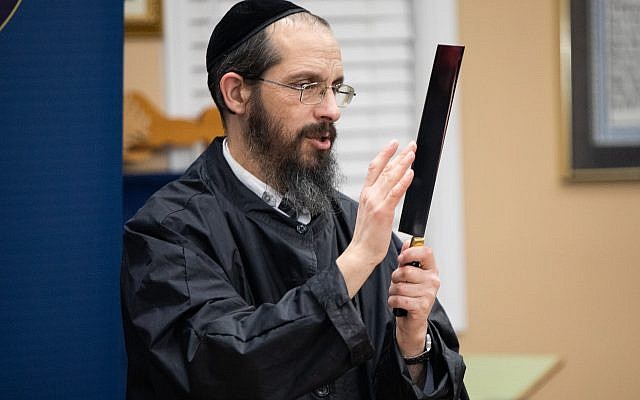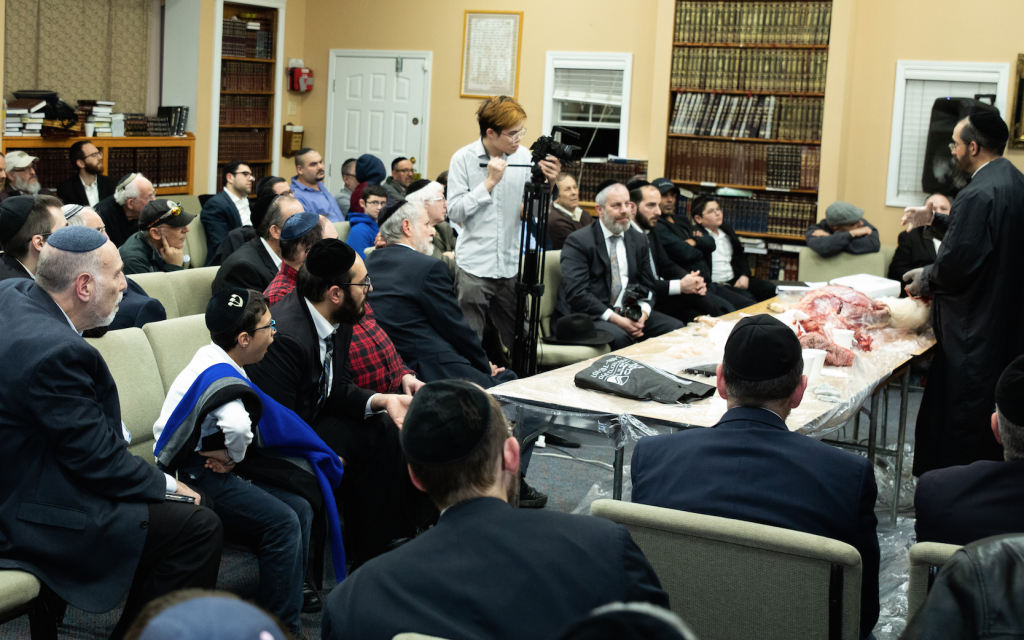Firsthand Lessons in Kashrut
More than 40 people gathered at Kollel Ner Hamizrach to learn exactly what goes on behind the scenes of meat kashering.

Most people would be perfectly happy buying their kosher meat in a supermarket and never giving a second thought to its origins. But more than 40 people gathered at Kollel Ner Hamizrach Jan. 9 to learn exactly what goes on behind the scenes of meat kashering.
Rabbi Amitai ben David is a world-renowned expert in the laws of shechita and treifa, the rules for slaughtering animals and ensuring that the animal is not treif, or non-kosher. The event, put on with the help of Agudath Israel of America, coincides with the laws of schechita and treifa in the Daf Yomi cycle – the over seven-year process of studying one page of Talmud each day.
“It was an opportunity for people who are learning the daily Gemara schedule to have a hands-on experience gaining a better understanding of these laws,” said Rabbi David Kapenstein, executive director of Kollel Ner Hamizrach.
Ahead of the event, ben David slaughtered a ram and a chicken, explaining that it was important to understand “what a longer journey the meat has had before we get it on our plate, and how much we have to invest and take care to have the meat Hashem told us to eat.”
To begin the presentation he showed off the tools involved in the process, explaining the reasoning behind each. For example, the knife must be twice as long as the width of the animal’s neck in order to ensure the kill is clean and without pain.
“We have different types of knives for different types of animals and birds,” he said. “We have two pipes that go along the neck, the esophagus and the windpipe, and we have to cut both at once.”

He also skillfully demonstrated how to test a knife’s edge ahead of the shechita, first with a fingernail and then with the flesh of his thumb, running both up and down the blade to feel for deformations without cutting himself.
“These days no one checks with the flesh, because our knives are so good and thin that you can feel everything with the nail,” ben David said. “We cut with this knife because it is painless, because it’s so smooth no piece of the flesh gets torn.”
Following the demonstration of the tools, he began cleaning and checking the ram according to the Talmudic laws. He was careful to specify that each check does not need to be performed normally, unless something is suspected to be wrong with the animal.
Among the steps ben David demonstrated for educational purposes, were checking the brain, the lining around the stomach and the intestines for any signs of holes or ruptures that would render the animal treif.
“It brings it to life for people who are not so familiar with animals and the anatomy. It gives them an opportunity to understand what the Gemara is talking about,” Kapenstein said.
He removed the internal organs and blew into the lungs, inflating them, in order to ensure they were intact — a requirement for the animal to be kosher. Following the ram demonstration, he also demonstrated the laws of kashrut associated with a chicken.
Kapenstein also explained the process by which he acquired the animals for the event. He signed up for a Georgia agricultural website and publication to track down a goat or sheep between 60 and 100 pounds, per ben David’s instructions.
“I called a woman who had a classified ad that was selling sheep, and I asked to purchase one from them,” Kapenstein said. “I was a little worried because she said it was a very friendly animal and I was concerned she was going to say, ‘I don’t want you slaughtering my favorite sheep,’ but in the end, … she had no problem with it.”
Kapenstein also added that even though it was for educational purposes, it’s still difficult to watch any animal being slaughtered.
“I guess after a while you might get used to it, but to watch the life force of any being leave is a difficult thing to watch,” he said, adding that while the event is a unique opportunity to learn about our food, many people would be very happy never seeing it firsthand.
The majority of the meat from the presentation didn’t go to waste either, with community members taking home cuts, except for the hindquarters, which aren’t kosher unless prepared in a complex manner.



comments